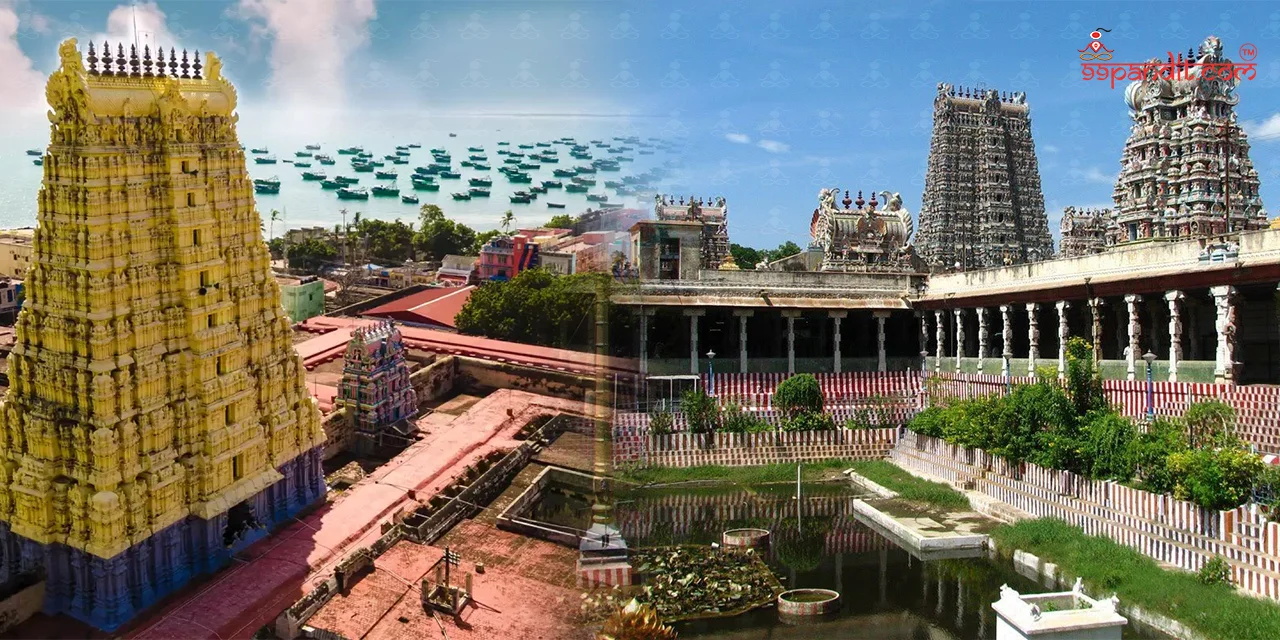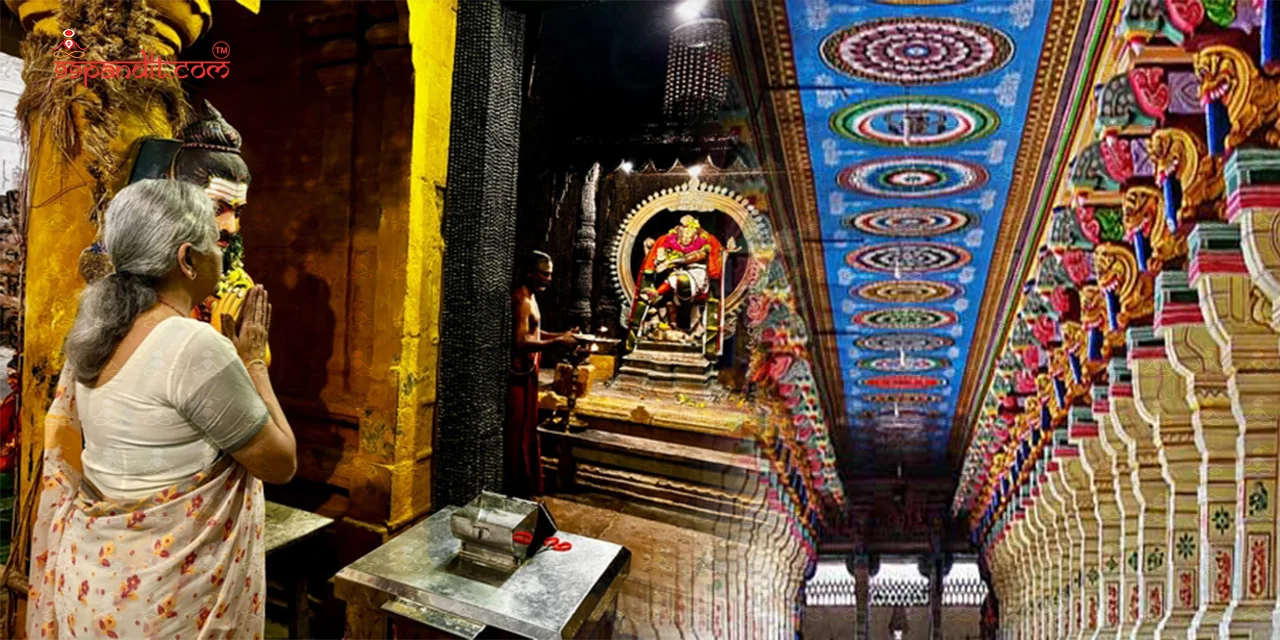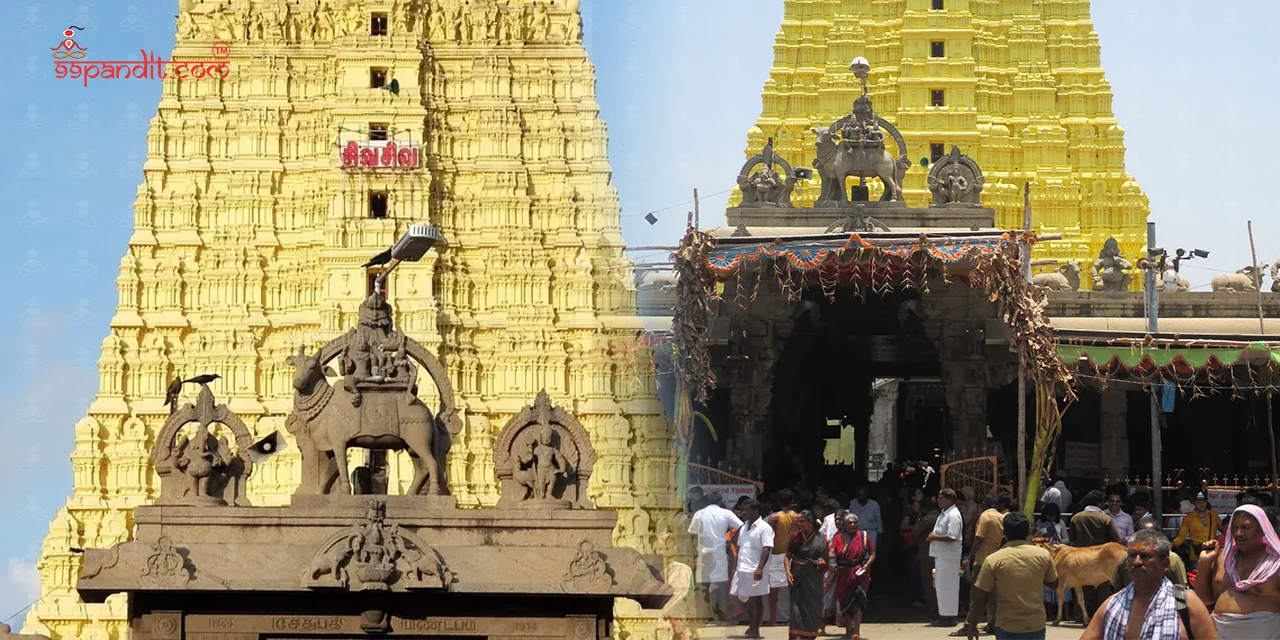Top 7 Famous Temples in Varanasi You Can’t Miss
Famous Temples in Varanasi: Varanasi, also called Kashi or Banaras, the city of Lord Shiva, is believed to achieve liberation.…
 0%
0%
Sri Arulmigu Ramanathaswamy Temple is known for its holy corridors and divine darshan. Learn more about this temple now!

Sri Arulmigu Ramanathaswamy temple, located in Tamil Nadu, is one of the most auspicious temples of India.
The revered temple devoted to lord shiva is not just a significant place for Hindus but also a masterpiece of Dravidian structure.
When you walk through the infinite corridors and marvel at amazing ancient architecture, you will be surprised to find spiritual peace.

Linked to the epic Ramayana, the temple has a rich history associated with it. According to the legend, Lord Ram prayed here himself. Because of its calm vibe and legend, it has become a famous temple.
The blog will go through the fascinating 22 wells inside the Sri Arulmigu Ramanathaswamy temple.
Each well has its unique spiritual and mythological importance. Lord Ram’s quiver provides blessings varying from wealth and good health to the elimination of sins.
We will underline the architectural marvel, rituals, and practical details to guide with visit planning to the revered temple.
The timing of Ramanathaswamy temple for devotees opens from 5:00 AM to 1:00 PM and from 3:00 PM to 9:00 PM every day.
It’s preferred to visit the temple early in the morning or late in the evening to avoid the crowd and have a convenient darshan.
| Time | Activity |
| 5:00 AM | Temple Opens |
| 1:00 PM | Temple closes for the afternoon |
| 3:00 PM | Temple reopens |
| 9:00 PM | Temple closes for the night |
The Ramanathaswamy Temple does not charge admission. However, special darshan, rituals, and pujas come with minor fees.
For the most recent details on costs and hours, it is advised to visit the temple’s official website or get in touch with the administration.
The Sri Arulmigu Ramanathaswamy temple is known as one of the 12 Jyotirlinga temples. The sacred shrine is dedicated to Lord Shiva.
As per the hindu mythology, the temple was created by Lord Rama, along with his consort Goddess Sita and brother Lakshman.
They worshipped together with lord shiva to remove their sin of killing Ravan, the brahman demon king.
The temple is constructed with its majestic corridors, huge sculptured pillars, and intricate crafting, making it an architectural marvel.

BOOK TO GET 100% FREE CALL FROM PANDIT TO DECIDE DATE (MUHURAT)

The Ramanathaswamy Temple is established on Rameswaram Island in Tamil Nadu. The temple is dedicated to lord shiva.
The Sri Arulmigu Ramanathaswamy Temple is known among the 275 Paadal Petra Sthalams. These are praised in the hymns of Saivite saints such as Appar, Sundarar, and Tirugnana Sambandar.
The legend says, the Lingam at Ramanathaswamy temple was situated by lord Rama himself before going to Sri Lanka.
This is one of the Char Dham pilgrimage sites. The temple was originally constructed by the Pandya dynasty during the 12th century.
This temple has India’s longest temple corridor, then later added by King Muthuramalinga Sethupathy.
The temple has been renovated and grown over the years, it attracts people from Shaivite, Vaishnavite, and Smartha customs due to its sacred significance.
The right time to plan your visit to Ramanathaswamy temple is in the winter season (November to February). This time is considered the peak tourist season for the Ramanathaswamy temple.
The weather during this time is pleasant and comfortable, making it the right time for temple visits and outdoor activities.
The temperature varies from 20°C to 30°C, which makes for a comfortable atmosphere for pilgrims.
People who are likely to witness temple rituals must plan their visit to overlap with Maha Shivaratri (February/March) or the annual Thirukalyanam occasion (July/August).
The legend of Sri Arulmigu Ramanathaswamy temple is Lord Rama, who had honoured lord shiva here.
Lord Ram was the incarnation of lord Vishnu. While coming back from Sri Lanka and killing the brahmin king Ravan, he offered a prayer to lord shiva.
Ravan abducted Goddess Sita, and he was a brahmin king. When lord ram killed him to end his sins and relieve Goddess Sita, he had agreed to seek penance by honouring lord shiva.
To offer prayers, Lord Ram asked Lord Hanuman to get a Shiva linga from the Himalayas.

Though Hanuman was unable to return with the lingam on time, Goddess Sita created a lingam herself to offer.
Then lord Ram together performs prayers at the pre-decided time. This made lord shiva pleased, and blessed Lord Ram by manifesting himself in the lingam.
It’s considered that the same lingam is now known as the main sanctum of the temple. According to the legend, the lingam brought by lord hanuman has been kept in the temple.
That is called Vishwalingam or Hanumalingam. According to the instructions of lord ram, prayers are offered to Hanumalingam first before presenting prayers to lord Ramanathaswamy.
The history of Sri Arulmigu Ramanathaswamy temple is mainly dedicated to the offering to lord shiva by Lord Ram.
This is considered one of the twelve jyotirlingas where Shiva is pleased as the ‘pillar of light’.
The hindu mythology states that the temple marks the place where lord Ram worshipped Shiva to relieve them from the sin of killing Ravan. The temple is a site of immense religious significance.
Lord Rama is said to have worshipped Lord Shiva here because he felt bad about murdering the Brahmin Ravana.
But as the island lacked temples, he dispatched Lord Hanuman to retrieve the Shivlinga from Mount Kailash.
If Hanuman did not bring the Shivling, Goddess Sita made it out of sand. Shiva Linga was a place of worship for Lord Rama.

BOOK TO GET 100% FREE CALL FROM PANDIT TO DECIDE DATE (MUHURAT)

The first to be honoured is the Shivalinga, Vishwalingam, who was born to Hanuman.
The temple was later built in the 15th century by King Udaiyan Sethupati and the Vaishya inhabitants of Nagoor.
Tirumalaya Sethupathi split the second section of the temple’s southern section in the sixteenth century. At the entrance are the statues of Tirumalaya and his son, established at the temple door.
The Ramanathaswamy Temple’s current design is thought to have been developed during the 17th century. The expert, King Kizhavan Sethupathi, led the temple’s development.
The participation of Jaffina Raja of the Sethupathi kingdom has been important in building the temple.
The architecture of the Ramanathaswamy temple is completely awe-inspiring. The complex has spread over 15 acres and is decorated with huge gopurams and long corridors.
The temple consists of the longest corridor between the hindu temples in India, extending across 1220 meters in length.
The Ramanathaswamy temple premise has 2 gopurams: the eastern gopuram and the western gopuram. The eastern gopuram is the main entry, with a height of 126 feet.
These gopurams are stunningly decorated with sculptures and carvings presenting multiple deities and mythological scenes.
The Ramanathaswamy temple corridors are called the ‘Hall of Thousand Pillars’, which is a striking feature. These are supported by 1212 pillars carved with exquisite details.
The sheer scale and balance of these pillars are a testament to the structural carving of the Dravidian pattern.
The sanctum has the main deity of Lord Ramanathaswamy, in the form of a lingam. There are two other lingams as well in the temple: the Ramalingam, which is considered to be set up by lord Ram, and the Vishwalingam that is brought by lord Hanuman from Kailash. Followers first honour the Vishwalingam before worshipping Ramalingam.
The Sri Ramanathaswamy temple adheres to a strict schedule of rituals and pujas. The day begins with the Palliyarai Deepa Arathana (morning prayer) and concludes with Palliyarai pooja (night prayer). A few of the main rituals consist of:
The ritual of Spadika lingam darshan is one of the most important rituals performed at the temple. The Spadika lingam, built of crystal, where followers offered special prayers in the early morning. People believe that the ritual removes their sins and blesses them spiritually.
Another ritual is abhishekam, which is a ritualistic bathing of the idol with multiple sacred substances, including milk, curd, honey, gangajal, and sandalwood paste. The custom is scheduled at various times in the day and thought to be auspicious.
A special puja is performed twice a month, pradosham, during the twilight period. This is believed to be the most sacred time to honour lord shiva. In this ritual, Nandi is also honoured along with lord shiva.
Apart from this, the Ramanathaswamy Temple is popular for its vibrant and grand rituals. A few of them are below:
The legend of Sri Arulmigu Ramanathaswamy temple is known for its architectural splendour and beautiful craftsmanship.
The temple premise spans more than 15 acres and present a fusion of Dravidian and Vijayanagara structural styles.
The main thing of the temple is its stunning corridors, called ‘Prakarams’, which are thought to be the longest in any hindu temple in the world.

Outer corridor extends over 6 km, with charmingly carved pillars and ornate sculptures that show mythological tales and characters from hindu scriptures.
The temple consists of multiple sacred tanks or ‘teerthams’. Taking a holy bath in these sacred tanks is considered an important ritual for visitors visiting the temple.
The most auspicious tank is the Agni teertham, located on the seashore, where followers thought that lord ram removes their sins. The temple even has Gandhamadhana Parvatham, a small hillock where lord Hanuman is thought to have hopped to Lanka.
Agni theertham snanam is an important ritual at Ramanathaswamy temple, which includes Agni theertham divine waters before moving into the primary part of the temple.
The availability to reach the Sri Arulmigu Ramanathaswamy temple is very convenient and easy. The route is connected by all modes of transportation, like air, rail, and road.
The pilgrims can reach the temple from Madurai airport, which is 174 km away. The airport at Madurai has frequent flight services between Ramanathaswamy temple and all metro cities like Chennai, Bengaluru and Delhi.
The airport offers transport services via taxi and buses that take the passengers to Rameshwaram.
Time: It takes between 3.5 to 4 hours to drive.
Rameshwaram railway station is the nearest to Ramanathaswamy temple, which is linked to Coimbatore and Madurai, and Chennai.
Various pilgrims use the station as an important stopover while travelling around India.
People might find the journey from Madurai to Rameshwaram via the Pamban bridge the most sightseeing.
Major Train Routes: Chennai, Madurai, Coimbatore
The major cities of Rameshwaram are Chennai (560 km), Madurai (174 km), and Trichy (220 km), which extend to Rameshwaram as these are well-kept highways.
The town offers an easy way to travel via road or through buses run by the government and the private sector, and taxi services.
While visiting the Arulmigu Ramanathaswamy temple, it’s essential to wear a decent dress. Here are the dress codes you need to follow:
A sacred sea, Agnitheertham, was established around the Ramanathaswamy temple. It’s thought that taking a dip in the holy water of this sea relieves one from past sins and cleanses their soul. Followers often perform the customs and prayers here before stepping into the temple.
The next place is to explore the ‘tip of the bow’; this is a ghost town situated at the southern tip of Pamban Island.

BOOK TO GET 100% FREE CALL FROM PANDIT TO DECIDE DATE (MUHURAT)

The place is most known for its beaches, and the old town was destroyed by a cyclone in 1964. This is believed to be the place where lord ram created the Ram Setu to get to Lanka.
About 3 kilometres from the Ramanathaswamy temple, Gandhamadhana Parvatham is located.
It has a two-storeyed mandapam with the sign of lord rama’s feet on a chakra. The hill gives panoramic views of Rameshwaram and the iconic sea view.
There are 22 stairs at the Arulmigu temple. “Moksha Stairs” is the name of these stairs. It is thought that by going down these stairs and having a bath, one can find salvation. Here are some details on 22 stairs:
Within the complex of the Sri Ramanathaswamy temple, 22 wells have been constructed. Other wells found outside the temple have salty water.
But the water from the temple’s well is sweet. This is said that wells are created by the arrows of lord ram.
He pleased the waters from multiple pilgrimage sites to pour water into the wells. Hence, the wells are known as pilgrimages.
One important Hindu site of devotion in Rameshwaram, Tamil Nadu, is the Sri Arulmigu Ramanathaswamy Temple.
It contains the Shivalinga, also known as Lord Shiva’s lingam, which was worshipped by Lord Rama.
The temple is renowned for its lengthy hallways and construction in the Dravidian style. There are twelve Jyotirlingas, including the Ramanathaswamy Temple.
The Pandya kingdom extended the pilgrimage site in the 12th century. The shrines were renovated by Jayaveera and Gunaveera Cinkaiariyan.

100% FREE CALL TO DECIDE DATE(MUHURAT)

Table Of Content
Filters by categories
All Pujas
Puja On Special Events
Upcoming Pujas
Dosha Nivaran Pujas
Mukti Karmas
Filters by Trending Topics
Filters by Regions
North Indian Pujas
South Indian Pujas